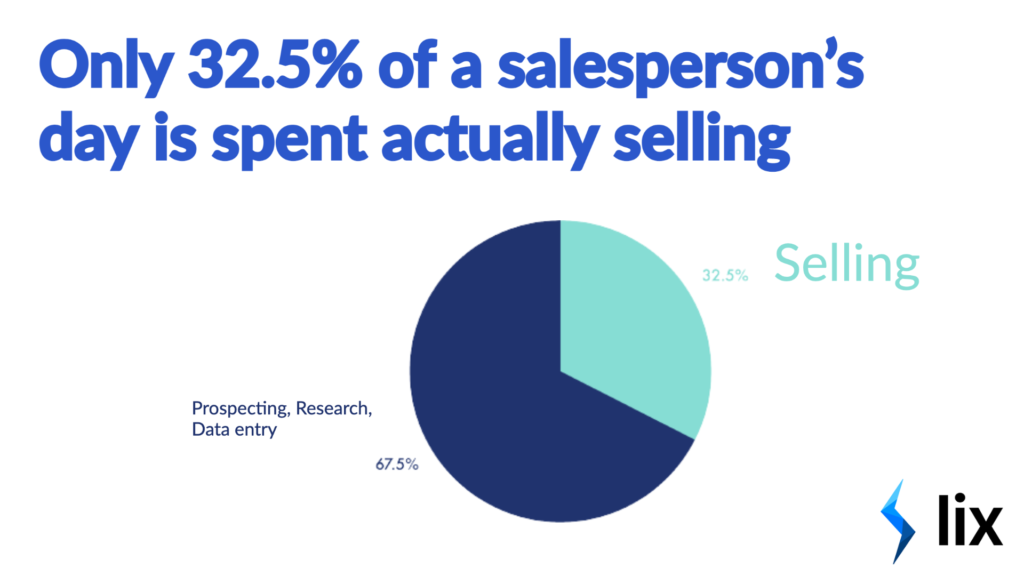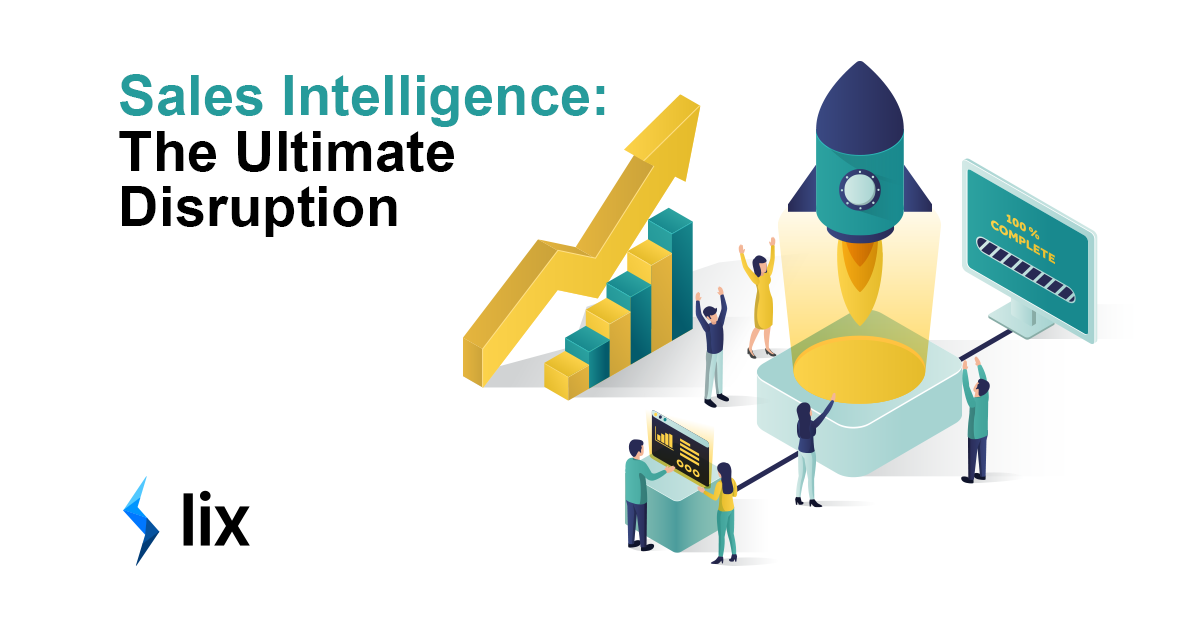Sales Intelligence: The Ultimate Disruption
Sales intelligence has reached a tipping point. The sheer volume of freely available business data, combined with falling entry costs and a change-igniting global pandemic, is proving to be the trifecta of conditions necessary for what I believe is the largest leap forward in sales history.
Let me explain.
Just 33% of a salesperson’s day is spent engaging with customers, with the other 66% being taken up with prospecting, administration and research tasks. If human interaction is the key to sales, then this allocation of time and energy is completely upside down.
That’s a serious problem.
I believe that for the first time in history, we have a solution to that problem – sales intelligence. Imagine, if you will, the salesperson’s ‘second brain’: a processing powerhouse that reps can call upon to carry out these tasks for them. A partner in prospecting, freeing them up to spend more time connecting and less time administrating.
That is what sales intelligence is about to do for sales and it is time for you to make a leap forward… or get left behind.
In order for me to give context to bold claims, allow me to take you on a journey back to the dawn of advertising, a time when marketing and sales lived in technological harmony.
The History of Sales & Marketing
Almost 2,000 years ago, in 1st century CE, a gentleman named Umbricius Scaurus was the Roman Empire’s leading manufacturer of ‘garum’; a luxury fish-based sauce loved by Roman high society. We know all about Scaurus’ and his ancient fish sauce for two reasons: the preservation of Pompeii (thanks Vesuvius!) and Scaurus’ talent for sales and marketing.
During the excavation of Pompeii, archaeologists discovered mosaic advertisements for Scaurus’ garum in his family home and the local market. Advertisements that talked about the quality and pedigree of his particular fish sauce. Urns stamped with the recognisable Scaurus label have since been discovered as far away as modern France.

The term ‘marketing’ first appeared in dictionaries much later, during the 16th century, referring the process of selling at market. The term came from merchants, like Scaurus, finding ways to bring new customers to their doors. Customers that could be sold to.
The marketing channels available (mosaics, urns, brass plates, painted banners…) and the point of human interaction – the merchant at their stall – were perfectly balanced. The marketing drew them in, and the merchant closed the deal. Sales and marketing existed in this person-to-person harmony for many centuries.
Until it didn’t.
Merchants and markets fell to the industrial revolution, replaced by general stores and the supermarket. The Gutenberg press gave us the newspaper and with it, print advertising. During the advertising boom of the 1920s, the terms B2B and B2C were first coined, marking a split between the two. 1955 saw the first TV ad broadcast on ITV, the world’s first commercial TV channel.

The days of the merchant manning their stall was long gone. Consumer goods no longer needed human contact to close the deal. Advertisers could present a product, educate the consumer and convince them to purchase long before they ever stepped into a store.
Person-to-person selling was only required where costs were high and trust building was crucial: b2b and high-ticket items.
A chasm had formed, between the old ways of selling and the new.
The dawn of the internet
Web 1.0, the first iteration of the internet, widened this chasm even further. Uptake was slow, at first – new technology always takes a while to reach widespread adoption – but it was coming.
1990 saw the first (albeit limited) search engine: Archie. In 1993, clickable ad banners began appearing on websites. The digital marketing revolution had begun.

These technological advancements allowed marketers and advertisers to do something that person-to-person selling couldn’t match – messaging at scale. The evolution of these technologies gave marketers the ability to push their message out to ever more people. To track, to ‘personalise’ and convert at a scale never before imagined.
At the click of a button, a modern marketer can reach millions of people across the globe, in a matter of minutes.
Marketing technology left sales in the dust.
It’s true that marketing tech can be leveraged to help reps, too. The same channels and tactics exist in B2B lead generation as they do in B2C marketing: PPC, SEO, content marketing, webinars… all drive inbound leads and (hopefully) sales, but if a product or service truly requires person-to-person connection to get over the line, there’s a bottleneck. Salespeople, like all of us, only have so much time in their day, much of which is taken up by admin, research and prospecting.
There’s an important point for us to remember, here. Having a ‘human in the loop’ is not about pushing prospects into a purchase, it’s about building trust and forging personal relationships in a way that marketing alone cannot.
The true magic of sales lives in connection, in those moments where the expertise and intuition of the rep helps to solve a problem for the potential buyer. Where trust is built, and loyalty is won. That is what all truly great salespeople know and strive for.
This poses a question, one that – if answered – could propel sales into a whole new era:
How do we scale personal relationships?
Scaling personal relationships
Salespeople know the bottleneck of time is a problem. Countless surveys and studies show that reps feel hamstrung by unproductive prospecting and stifled by administration. According to one such study carried out by CSO insights, salespeople on average spend just 33% of their day actually talking to prospects, 71% of reps feel they spend too much time doing data entry and 68% of businesses report struggling with lead generation.

McKinsey’s comprehensive study on Automation and the future of work assessed the “automatability” of over 2,000 workplace activities in 2018 and concluded that over 40% of time spent on sales tasks could be automated.
These statistics are not anomalies. A casual Google search will reveal a multitude of blogs and papers that mirror these concerns. Salespeople (and therefore, the businesses they represent) are being held back from achieving their true potential. Their time, such a precious resource in relationship building, is being squandered on peripheral tasks.
Enter: Sales Intelligence
Sales intelligence (SI) refers to a broad range of tools and technologies designed to enable organisations to find and utilise sales-related data and insights.
In plain English, sales intelligence tools help salespeople find, extract and sort information in an instant: slashing the time required for quality prospecting, research and lead generation.
Better still, where sales intelligence meets sales productivity, these tools relieve reps of the need for monotonous data entry. Robotic process automation (RPA) and artificial intelligence (AI), the primary drivers of SI, have the power to eradicate the time lost to such tasks.
This is it. The salesperson’s second brain. The key to scaling personal connection.
Quality lead generation becomes a source of delight, not stress. Collecting information on prospects, discovering those all-important shared interests, finding contact information, spotting buying signals… all become effortless with the right tools.
There’s a force multiplier effect, here. In freeing your reps from manual prospecting and data entry you don’t just free up the 66% of their day spent on these tasks, you free them from the power drain of even thinking about it.
Imagine a sales team laser-focused on building relationships at 3x the rate they ever could before. A team with more time to spend nurturing, educating and exciting your customers.
For some businesses, this dream is already becoming a reality.
Sales intelligence has been a category on G2 since way back in 2012. Five long years ago, Harvard Business Review told sales leaders that it was time to develop ‘Machine Intelligence’. Some business leaders listened, and those that did, prospered.
Salesforce’s State of Sales (2020) shows that high-performing sales teams are 4.1x more likely to use AI and machine learning applications than their peers. According to Deloitte, 83% of B2B AI-adopters are seeing rapid and positive changes, with 53% achieving moderate benefits, and 30% experiencing substantial benefits.
As you might imagine many of these early adopters were large firms, or rather, firms with large budgets. This is no longer the case. In accordance with Moore’s Law, as computing power increases, it decreases in relative cost at an exponential pace.
Removing cost as a barrier of entry is a key driver for the sales intelligence revolution. Sales intelligence is becoming democratised. Salespeople with a drive to achieve don’t need the financial backing of their organisation. Entrepreneurs and small business owners can now utilise the same technology as the behemoths of business. For anywhere upwards of $40 a month, they can get in on the action.
Salespeople are cottoning on to the fact that the old ways are dying, and a new world of sales technology is upon us. A world in which they can focus on the magic of human connection.
Grand View’s Sales Intelligence industry report indicates that:
“The global sales intelligence market was valued at $2.3 billion in 2019 and is expected to reach $5.6 billion by 2027, growing at a CAGR of 10.5% from 2020 to 2027.”
These figures, published early in 2020, may even be conservative as to the potential for this sector. The Covid-19 pandemic has rapidly accelerated business transformation, in many cases lighting a fire under the (usually molassic) decision making process of large corporations. We’re in an age of flux, where digital change is being implemented at a speed never before seen.
The sales intelligence revolution is upon us. We are at the dawn of a new era and you have to decide as a salesperson, entrepreneur or business leader – will you take the next leap forward, now, or let your fish sauce be forgotten?

Try Lix & get 50 free leads!
Supercharge your pipeline with monthly, free, targeted leads. Click here to get started.
If you’d like to read the rest of the series, subscribe to our email list. If you’d prefer to just spread the good word of sales intelligence, hit the icon below for your preferred community.
